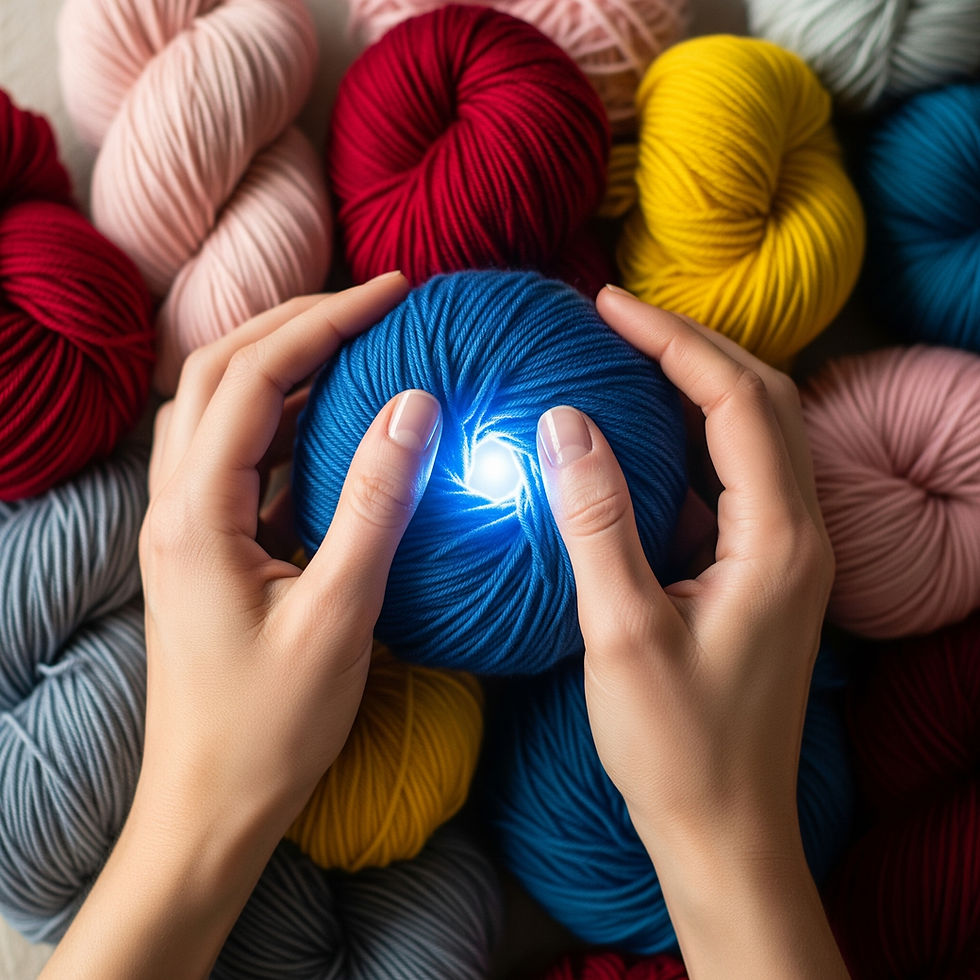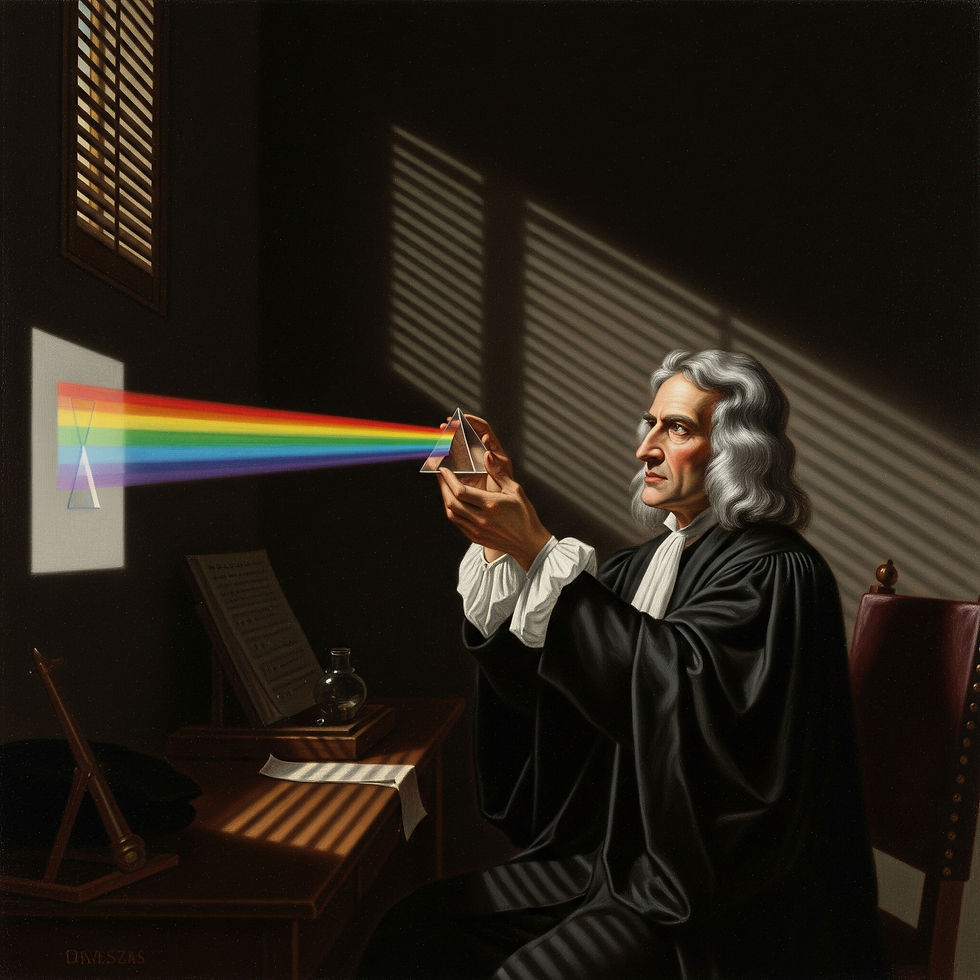History of chromotherapy: From ancient Egypt to your knitting and crochet.
- Elena Acosta
- Aug 5, 2025
- 4 min read

From Pharaohs to Physics: Why We Crave Color in Our Craft
Have you ever stood before your yarn stash, needing to start a new project, and felt an almost magnetic pull towards a specific color? A deep, calming blue when you feel stressed, or a vibrant yellow when you need a boost of energy? That intuitive choice is no accident; it's a form of ancient wisdom.
In this article, we'll travel back in time to discover the fascinating roots of Chromotherapy, a practice that unites color, light, and well-being. We'll explore how ancient civilizations harnessed the power of color and how modern science is finally validating this powerful healing tool that we, as crafters, use instinctively in every project.

The History of Chromotherapy: From Pharaohs to Physics and Why We Crave Color in Our Fabric
Egypt and China: Baths of Light and Energetic Balance
The history of healing with colors begins in ancient Egypt. There, architects built solariums with colored glass for therapeutic purposes, believing that sunlight filtered through different hues had restorative properties for the body. Similarly, in traditional Chinese medicine, physical well-being was attributed to a balance of energies where certain colors played a fundamental role.
Greece and India: The Elements, Chakras, and Color
In ancient Greece, color was associated with the four elements (water, fire, earth, and air), which were in turn linked to bodily fluids. It was Aristotle who developed one of the first color theories, stating that all colors were derived from light (white) and darkness (black).
Meanwhile, in India, Ayurvedic sages discovered that the body's energy centers, known as chakras, corresponded to the major glands and assigned specific colors to them, using these hues to balance the body and mind.
Avicenna: The Physician Who Prescribed Colors
Later, Avicenna, the great Persian physician and philosopher, brought these ideas into the field of formal medicine. In his work "The Canon of Medicine," he asserted that certain colors were associated with symptoms of diseases. He created a chart linking specific colors to temperament and ailments, using color for both diagnosis and treatment. He observed, for example, that looking at the color red could stimulate blood flow—a revolutionary idea for his time.
The Scientific Revolution: Newton Unweaves the Rainbow
Although color was used therapeutically for millennia, it did not achieve a formal scientific status until 1660. It was then that Isaac Newton, through his famous experiment with a prism, analyzed and proved that white light was, in fact, composed of the seven visible colors of the spectrum.
“Have not the small particles of bodies certain powers, virtues, or forces, by which they act at a distance, not only upon the rays of light for reflecting, refracting, and inflecting them, but also upon one another for producing a great part of the phenomena of nature?” — Isaac Newton

Newton's work revolutionized optics and physics, giving us a new language to understand color. Thanks to him, we now know that each color has a specific wavelength, from red (the longest at 780 nm) to violet (the shortest at 380 nm).
What Newton began in physics, modern science continues in biology and neuroscience, explaining how these colors affect us.
How We Perceive Color: A Dance of Light in Your Retina
The color we see is essentially the light that an object does not absorb. As Shahid (2023) explains, when light hits a green object, its surface absorbs all other colors and reflects only the green wavelength. This reflected light is what the photoreceptors in our retina perceive. Following this rule, an object that reflects all colors appears white, while one that absorbs them all appears black.
The Rhythm of Life: Colors and Our Circadian Rhythms
Science has discovered that light (and therefore, color) is the primary regulator of our circadian rhythms—the internal 24-hour cycles that manage our sleep-wake patterns. The process is fascinating:
Light enters our eyes and sends a signal to our "master clock" in the brain, the suprachiasmatic nucleus (SCN).
The SCN, in turn, tells the pineal gland whether to produce melatonin, the sleep hormone.
Blue light (present in daylight and on screens) is the most potent signal to stop melatonin production and keep us awake and alert.
This is the scientific basis of modern chromotherapy: exposure to certain colors sends direct signals to our brain that can alter our hormonal state, our mood, and our energy levels.
Bringing Ancient Wisdom to Your Needles
From the sacred solariums of Egypt to the modern laboratory, the power of color to influence our well-being is an undeniable thread in our history. What was once sacred wisdom is now becoming scientific fact.
So, the next time you choose a yarn for your project, remember this legacy. You are not just choosing a pretty shade; you are tapping into ancient knowledge and a powerful biological process. You are, in your own way, practicing a form of therapeutic crafting that has been thousands of years in the making.
What color are you knitting with today, and how does it make you feel? Share your experience in the comments!
Referencias
Baker, L. S. Jr. (2021) "Sanctuary Colors through Egyptian Eyes," Journal of the Adventist Theological Society: Vol. 32: Iss. 1, Article 5. https://digitalcommons.andrews.edu/jats/vol32/iss1/5
Gul, S., Nadeem, R. K., & Aslam, A. (2015). Chromo therapy- An effective treatment option or just a myth?? Critical analysis on the effectiveness of chromo therapy. American Research Journal of Pharmacy, 1(2), 62–66.
Hoda, F. S., & Mahoklory, S. S. (2022). The Effects of Chromotherapy on the Stress Level of Patients with Hypertension. Jurnal Berita Ilmu Keperawatan, 15(1), 1–7. https://doi.org/10.23917/bik.v15i1.14812
Shahid, S. K. (2023). Color therapy: Clinical applications of colors in adults and children. Hong Kong Journal of Paediatrics Research, 6(3), 1–8.https://www.hkpaediatricjournal.com/HKJPR_202363_01.pdf
Somanadhapai, S., & Kumar, N. S. (2024). Application of Environics Color Slides in Optimizing the Health and Well-being. International Journal of Indian Psychology, 12(2), 693–699. https://doi.org/10.25215/1202.062


Comments